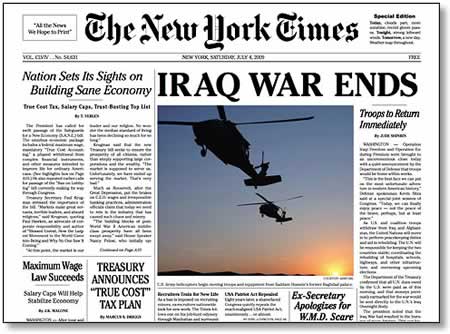In August of 2007 at his Town Hall on Iraq, one of the bones of contention between members of the audience and Sen. Ron Wyden was his repeated statements about the implication of Iran in providing weapons to people making attacks in Iraq. Each time he brought it up a hubbub would rise from the crowd — many of whom were uneasy about Bush administration intentions to attack Iran — and Wyden would assert that it was all real.
A number of reports since then have cast doubt on the scale and scope of Iran’s activities within Iraq (you’d have to be an idiot to think that there was no Iranian influence in Iraq given that many of the Shi’ite leaders in the government spent time in Iraq during Saddam Hussein’s reign). but the US military has repeatedly made claims about large weapons caces of supposed Iranian origin, only to have those stories disproved or walked back by the military themselves. By May of this year, even TIME magazine reported on the Iraqi pushback of the view promulgated by Wyden and others.
Indeed, the U.S. allegations appear to be based on speculation, spurred by the appearance about a year ago of a new breed of roadside bomb in Iraq. Explosively formed penetrators, or EFPs, proved effective at piercing American armor by firing a concave copper disc from a makeshift cannon, which transformed the slug midair into a molten jet of super-heated metal. Accusations that Iran was shipping the things into Iraq grew louder as U.S. casualties from the weapon rose. But no concrete evidence has emerged in public that Iran was behind the weapons. U.S. officials have revealed no captured shipments of such devices and offered no other proof.
And speaking of “captured shipments” brings us to the latest bit of information, based on a paper by Joseph Felter and Brian Fishman at West Point (via IPS’s Gareth Porter):
According to the data compiled by the task force, and made available to an academic research project last July, only 70 weapons believed to have been manufactured in Iran had been found in post-invasion weapons caches between mid-February and the second week in April. And those weapons represented only 17 percent of the weapons found in caches that had any Iranian weapons in them during that period.
The actual proportion of Iranian-made weapons to total weapons found, however, was significantly lower than that, because the task force was finding many more weapons caches in Shi’a areas that did not have any Iranian weapons in them.
…
The caches that included Iranian weapons thus represented just 2 percent of all caches found. That means Iranian-made weapons were a fraction of one percent of the total weapons found in Shi’a militia caches during that period.
…
Only two months before the new high-level propaganda push on alleged Iranian weapons supply to Shi’a militias, the U.S. command had put out a story suggesting that large numbers of Iranian-supplied arms had been buried all over the country. On Feb. 17, 2008, U.S. military spokesman Rear Admiral Gregory Smith told reporters that Iraqi and coalition forces had captured 212 weapons caches across Iraq over the previous week “with growing links to the Iranian-backed special groups”.
The Task Force Troy data for the week of Feb. 9-16 show, however, that the U.S. command had information on Iranian arms contradicting that propaganda line. According to the task force database, only five of those 212 caches contained any Iranian weapons that analysts believed might have been buried after the U.S. invasion. And the total number of confirmed Iranian-made weapons found in those five caches, according to the data, was eight, not including four Iranian-made hand grenades.
The task force database includes 350 armour-piercing explosively formed penetrators (EFPs) found in Iraqi weapons caches. However, the database does not identify any of the EFPs as Iranian weapons.
That treatment of EFPs in the caches appears to contradict claims by U.S. officials throughout 2007 and much of 2008 that EFPs were being smuggled into Iraq by the Iranian Revolutionary Guard Corps. The allegedly Iranian-manufactured EFPs had been the centrepiece of the U.S. military’s February 2007 briefing charging Iran with arming Shi’a militiamen in Iraq.
Press reports of a series of discoveries of shops for manufacturing EFPs in Iraq in 2007 forced the U.S. command to admit that the capacity to manufacture EFPs was not limited to Iran. By the second half of 2008, U.S. officials had stopped referring to Iranian supply of EFPs altogether.
Felter and Fishman do not analyse the task force data in their paper, but they criticise official U.S. statements on Iranian weapons in Iraq. “Some reports erroneously attribute munitions similar to those produced in Iran as Iranian,” they write, “while other Iranian munitions found in Iraq were likely purchased on the open market.”
The co-authors note that Iranian arms can be purchased directly from the website of the Defence Industries of Iran with a credit card.
Wyden implied that he’d seen hard evidence of Iran’s involvement in supplying weapons to Iraqi insurgents responsible for the deaths of American soldiers. I think it’s time for him to put his cards on the table or tell us how he;s going to provide actual oversight on stuff like this in the future.




